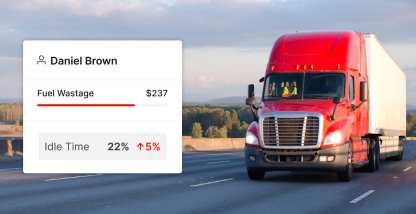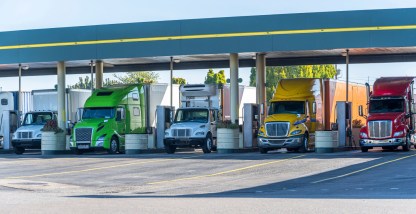In the last few decades, telematics technology has changed drastically. Staying on the leading edge of new telematics features has proven to be a significant competitive advantage.
So, where is telematics technology headed next? In this article, we’ll break down the 4 key changes that will shape the future of fleet telematics:
- Open marketplaces are replacing proprietary ecosystems
- Shifting from data to insights
- The rise of integrated video
- Evolving into a business management platform
Open marketplaces are replacing proprietary ecosystems
In the past, telematics providers operated in closed ecosystems. They would sell you a proprietary onboard computer that only communicated with their software. The provider chose which add-on applications were available, when they would be updated, and what data would be shared.
Then came the smartphone. The smartphone enabled any business to publish an app to a common piece of hardware that drivers often already had.
This allowed businesses to solve each driver’s problem with the solution that best fit their needs by simply downloading it from an app store. Apps from multiple providers can often be used side-by-side from a single device, whether there’s an integration or not.
The same is true on the back office and management side. In the past, not only were integrations limited, they were often expensive and required significant IT support.
App marketplaces and open APIs are changing this. With a modern app marketplace, integrating software can often be done with a few clicks of the mouse. No extra costs. No IT.
With open APIs, businesses have complete access to their data. Put simply, this means that if an integration doesn’t exist, you can create it with the help of a developer.
Together, these shifts have three big benefits for fleets:
- An ability to choose the best solution for every problem
- Streamlined operations by automating tasks between multiple platforms
- Getting increased insight from your data by being able to share it between software solutions
In the future, telematics will increasingly be integrated alongside your other software solutions and into your broader business operations. The days of operating in a silo are over.
Going from data to insights
Telematics collects a lot of data. Distance traveled, speed, fault codes, fuel usage, idling, and harsh braking are just a few of the many data points. While this data has great potential, its usefulness has historically been limited.
Why? Because it’s not the data itself that provides value, but the insights that can be gleaned from it. Often, the data has been presented in a spreadsheet-like format, forcing you to attempt to find problems, trends, and opportunities yourself. It’s a bit like trying to drink from a data firehose.
Modern telematics providers are increasingly focusing on insights. Rather than just presenting the data, modern telematics providers highlight what is out of the ordinary or where performance is trending under benchmarks. Here are a few examples:
- Are certain fault codes suddenly recurring on a vehicle?
- Is a driver having more critical driving events than usual?
- Are certain vehicles being underutilized?
Additionally, the next step is shifting from what has happened to what will happen. For example:
- How much detention time am I likely to experience at this shipper facility?
- Which drivers are likely to experience accidents in the future?
Going forward, the leading telematics solutions will essentially present you with a menu of fleet optimization ideas, and you will just need to choose which to implement first.
The rise of video
Data is powerful, but it’s only part of the story. Dash cams are being added to telematics systems to provide context around data.
For example, let’s say a driver has a few more hard braking events than usual. You ask them about it, and they claim other drivers cut them off. Is it true? Or are they driving dangerously? With data alone, it’s a guess. With integrated video, fleet managers can experience the event for themselves to assess risk and coach drivers accordingly.
The value of video also goes beyond safety. Fleets are increasingly using video for other situations such as proof the loading dock was blocked or to see how a vehicle was parked.
Moving forward, telematics providers will auto-analyze videos to identify risks and make coaching recommendations proactively. This will allow fleet managers to coach more drivers in less time, potentially resulting in a much safer fleet of drivers.
Becoming a business management platform
Modern telematics systems are evolving from a vehicle tracking tool to a platform to run your business on. For example, telematics systems can now help:
- Construction companies invoice customers based on equipment usage per job site
- Trucking companies dispatch loads and provide ETA alerts to customers without phone calls
This is just the beginning. Moving forward, more of the process to find, service, and bill customers will be handled through a telematics platform.
This is significant as the data captured by the telematics system can help find new opportunities for operational efficiency in a way disparate systems cannot. It also simplifies a fleet manager’s day as more key tasks can be completed from a single dashboard.
The future of fleet telematics is bright
Telematics systems have already come a long way from their start as a way to track vehicles. But, there is so much more to come. With open marketplaces enabling choice and connectivity, an increasing focus on insights, the integration of video, and the shift to becoming a business management platform, there’s a lot to be excited about in this space.
If your telematics system isn’t currently working on these initiatives, your growth may be restricted in the future. Be sure to choose a telematics partner with a vision for the future that will help your business grow.
For questions related to fleet telematics, request a demo or call us at 844-325-9230.









